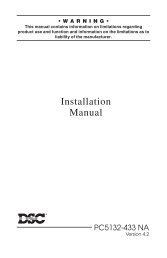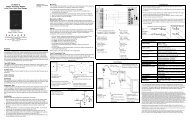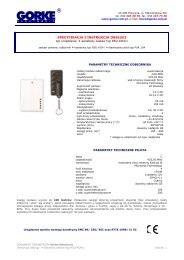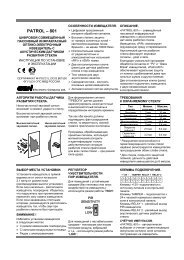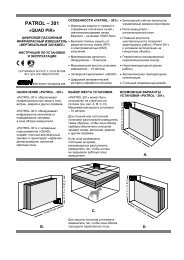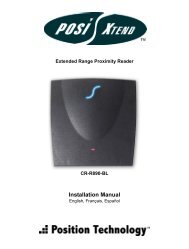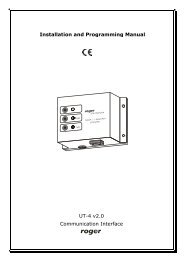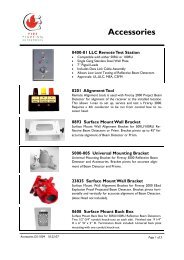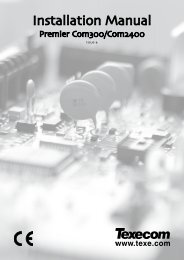ET082 User Manual - Eldes
ET082 User Manual - Eldes
ET082 User Manual - Eldes
Create successful ePaper yourself
Turn your PDF publications into a flip-book with our unique Google optimized e-Paper software.
GSM/GPRS COMMUNICATOR<br />
<strong>ET082</strong>
<strong>User</strong> <strong>Manual</strong> v1.2<br />
Safety instructions<br />
Please read and follow these safety guidelines in order to maintain safety of operators and people around:<br />
• GSM/GPRS communicator <strong>ET082</strong> (further referenced as system, device or communicator) contains a radio transceiver operating<br />
in GSM850/900/1800/1900 bands.<br />
• DO NOT use the system where it can interfere with other devices and cause any potential danger.<br />
• DO NOT use the system with medical devices if this is required in the manual of the medical device.<br />
• DO NOT use the system in hazardous environment.<br />
• DO NOT expose the system to high humidity, chemical environment or mechanical impacts.<br />
• DO NOT attempt to personally repair the system.<br />
• System labelling sticker is at the bottom of the device.<br />
System <strong>ET082</strong> is a device mounted in limited access areas. Any system repairs must be done only by qualified, safety aware<br />
personnel.<br />
Mains power must be disconnected before any installation or tuning work starts. The system installation or maintenance<br />
must not be done during stormy conditions.<br />
300mA power supply which must be approved by LST EN 60950-1 stan-<br />
The system must be powered by main 10-24V<br />
dard and be easily accessible.<br />
Any additional devices linked to the system <strong>ET082</strong> (computer, sensors, relays etc.) must be approved by LST EN 60950-1<br />
standard.<br />
External power supply can be connected to AC mains only inside installation<br />
room with automatic 2-pole circuit breaker capable of disconnecting<br />
circuit in the event of short circuit or over-current condition.<br />
Open circuit breaker must have a gap between connections of more<br />
than 3mm and the disconnection current is 5A.<br />
Phase<br />
Null<br />
PE<br />
AC 230V<br />
50 Hz/DC 24V<br />
<strong>ET082</strong><br />
USB cable<br />
Fuse F1 model - miniSMDC 500mA. Blown fuse cannot be replaced by the user and the replacement fuses have to be exactly<br />
the same as indicated by the manufacturer.<br />
The device is fully turned off by disconnecting 2-pole switch off device of the external power supply or any other linked<br />
device that the system <strong>ET082</strong> is powered from.<br />
The WEEE (Waste Electrical and Electronic Equipment) marking on this product (see left) or its documentation indicates that the product<br />
must not be disposed of together with household waste. To prevent possible harm to human health and/or the environ ment, the<br />
product must be disposed on in an approved and environmentally safe recycling process. For further information on how to dispose<br />
of this product correctly, contact the system supplier, or the local authority responsible for waste disposal in your area.<br />
Copyright © “ELDES UAB”, 2012. All rights reserved.<br />
It is strictly forbidden to copy and distribute information in this document or pass to a third party without an advanced written authorization from<br />
“ELDES UAB”. “ELDES UAB” reserves the right to update or modify this document and/or related products without a warning. Hereby, „ELDES UAB“<br />
declares that this GSM/GPRS communicator <strong>ET082</strong> is in compliance with the essential requirements and other relevant provisions of Directive 1999/5/<br />
EC. The declaration of conformity may be consulted at www.eldes.lt
Limited Liability<br />
The buyer must agree that the system will reduce<br />
the risk of fire, theft, burglary or other dangers<br />
but does not guarantee against such events. “EL-<br />
DES UAB” will not take any responsibility regarding<br />
personal, property or revenue loss while using the<br />
system. “ELDES UAB” responsibility according to<br />
local laws does not exceed value of the purchased<br />
system. “ELDES UAB” is not affiliated with GSM operators<br />
providing cellular services, therefore is not<br />
responsible for network services, coverage or its<br />
operation.<br />
Manufacturer Warranty<br />
The system carries a 24-month warranty by the<br />
manufacturer “ELDES UAB”.<br />
Warranty period starts from the day the system<br />
has been purchased by the end user. The warranty<br />
is valid only if the system has been used as intended,<br />
following all guidelines listed in the manual<br />
and within specified operating conditions. Receipt<br />
with purchase date must be kept as a proof.<br />
The warranty is voided if the system has been<br />
exposed to mechanical impacts, chemicals, high<br />
humidity, fluids, corrosive and hazardous environment<br />
or other force majeure factors.<br />
Package Content<br />
1. <strong>ET082</strong>........................................................................qty. 1<br />
2. <strong>User</strong> manual...........................................................qty. 1<br />
3. GSM antenna.........................................................qty. 1<br />
4. Jumpers...................................................................qty. 4<br />
5. Plastic standoffs....................................................qty. 7<br />
About <strong>User</strong> <strong>Manual</strong><br />
This document describes only basic operation<br />
and installation of <strong>ET082</strong> device. It is very important<br />
to read the user manual before starting to use<br />
the system.<br />
Contents<br />
1. General Information...................................................................... 4<br />
1.1 Operation Description ...............................................................................4<br />
2. Technical Specifications................................................................ 6<br />
2.1 Electrical & Mechanical Specifications...............................................6<br />
2.2 Main Unit, Connector, Pin & LED Functionality ..............................7<br />
2.2.1 Main Unit Functionality.................................................................7<br />
2.2.2 Connector Functionality...............................................................7<br />
2.2.3 Pin Functionality..............................................................................7<br />
2.2.4 LED Functionality.............................................................................7<br />
2.3 Connection Circuit.......................................................................................8<br />
3. Installation ..................................................................................... 9<br />
4. Skyrelio pavadinimas..................................................................10<br />
4.1 PSTN Line and GSM Connection Status Monitoring..................... 10<br />
4.2 Inputs & Оutputs........................................................................................ 10<br />
4.3 Remote Configuration of the Alarm System via DTMF................ 10<br />
5. Communication Modes & Methods............................................11<br />
5.1 Wiring Diagrams...................................................................................... 11<br />
5.1.1 No PSTN Connection................................................................... 12<br />
5.1.2 With PSTN Connection............................................................... 12<br />
5.1.3 With PSTN Connection through PBX..................................... 13<br />
5.2 Basic Mode................................................................................................ 13<br />
5.2.1 Voice Calls Method....................................................................... 14<br />
5.2.2 SMS Method................................................................................... 14<br />
5.2.3 Voice Calls + SMS Method......................................................... 15<br />
5.2.4 GPRS Method................................................................................. 16<br />
5.3 Advanced Mode...................................................................................... 17<br />
5.3.1 Voice Calls Method....................................................................... 17<br />
5.3.2 SMS Method................................................................................... 18<br />
5.3.3 GPRS Method................................................................................. 19<br />
5.3.4 CSD Method .................................................................................. 20<br />
6. Configuration & Control..............................................................21<br />
6.1 Ways of System Configuration........................................................... 21<br />
6.2 Remote System Configuration via GPRS Connection................ 21<br />
6.2.1 Establishing Remote Connection Between<br />
<strong>ET082</strong> System and Configuration Server......................... 22<br />
6.2.2 Connecting to ELDES Configuration Server<br />
using ELDES Configuration Tool Software...................... 22<br />
6.2.3 Ending the Configuration Process..................................... 23<br />
6.3 Configuration Parameter Set (SMS).................................................... 23<br />
7. Technical Support........................................................................27<br />
7.1 Restoring Default Configuration ...................................................... 27<br />
7.2 Upgrading Firmware.............................................................................. 27<br />
7.3 Technical Support................................................................................... 27<br />
8. Related products...........................................................................28
1. General Information<br />
Communicator <strong>ET082</strong> is a device for transmitting data from alarm system to monitoring station via:<br />
• PSTN (telephone landline);<br />
• Voice Calls (GSM audio channel);<br />
• Voice Calls (GSM audio channel) and/or to users via SMS message;<br />
• GPRS network;<br />
• CSD (fax line).<br />
<strong>ET082</strong> main applications & features:<br />
• Property security;<br />
• Data re-transmission to monitoring station via GSM/GPRS/CSD and/or to preset user via SMS;<br />
• Backup connection for PSTN;<br />
• PSTN status monitoring in case it is cut-off or disconnected;<br />
• Alarm system remote configuration via DTMF.<br />
4
2. Technical Specifications<br />
2.1 Electrical & Mechanical Specifications<br />
Power Supply 10-24V 300mA max<br />
Peak Current Consumption<br />
Current Used in Standby Mode<br />
GSM Modem Frequency<br />
Communications<br />
Supported Protocols<br />
Maximum Number of <strong>User</strong>s Receiving<br />
Alarm System Events by SMS Message<br />
700 mA max.<br />
120mA max<br />
850/900/1800/1900 MHz<br />
Voice Calls, SMS, GPRS, CSD<br />
Ademco Contact ID®, 4+2, Scancom, EGR100, Kronos, SIA IP<br />
5<br />
Maximum Number of <strong>User</strong>s for Input/Output Control 3<br />
Number of “Low” Level (Negative) Digital Inputs 3<br />
Allowable Input Values Voltage<br />
0... 1.45V; current: 0.8... 0.6mA<br />
Input Type<br />
NO (normally open)<br />
Number of Outputs 3<br />
Output C1 - C3 Circuit<br />
1 R OUT Open collector output.<br />
Output is pulled to COM when<br />
turned on.<br />
Maximum Commuting Output Values<br />
Dimensions<br />
Operating temperature range<br />
Generated Phone Line Values<br />
Dial Tone Frequency of Generated Phone line<br />
Voltage: 30V ; current: 50 mA<br />
130 x 73 mm<br />
-20...+55 o C<br />
Voltage: 18V; current: 25mA; impedance: 600Ω<br />
350 Hz<br />
For configurations<br />
UART<br />
DEF<br />
SIM CARD<br />
GSM<br />
MODEM<br />
ANT<br />
SET<br />
MODE<br />
USB<br />
JP9<br />
JP8<br />
F1<br />
INFO<br />
STATUS<br />
GSM<br />
L1 L2 L3 L4 RING TIP C1 DC+ COM C2 Z2 Z1 C3 Z3 COM<br />
Fig. No 2<br />
<strong>User</strong> manual ELDES <strong>ET082</strong> v1.2 5
2.2 Main Unit, Connector, Pin & LED Functionality<br />
2.2.1 Main Unit Functionality<br />
GSM MODEM<br />
SIM CARD<br />
ANT<br />
F1<br />
USB<br />
GSM network 850/900/1800/1900 MHz modem<br />
SIM card slot / holder<br />
GSM antenna SMA type connector<br />
Fuse model – miniSMDC 500mA<br />
Mini USB port<br />
2.2.2 Connector Functionality<br />
Labelling<br />
L1 - L4<br />
RING<br />
TIP<br />
C1 - C3<br />
DC+<br />
COM<br />
Z1 - Z3<br />
Description<br />
Landline or PBX contacts (according to backup mode)<br />
RING contact<br />
TIP contact<br />
Outputs<br />
Positive power supply contact<br />
Negative power supply contact / Common contact<br />
Inputs<br />
2.2.3 Pin Functionality<br />
Labelling<br />
DEF<br />
SET<br />
MODE<br />
JP8, JP9<br />
UART<br />
Description<br />
For restoring factory default settings<br />
For communication method of Basic mode set up<br />
For communication method of Basic mode set up<br />
For direct data transmission via PSTN with status monitoring<br />
For retreiving debug log<br />
2.2.4 LED Functionality<br />
Labelling<br />
INFO<br />
STATUS<br />
GSM<br />
Description<br />
Operation activity status<br />
Device status<br />
GSM network strength<br />
GSM Signal Strength Indication<br />
GSM signal strength is indicated by GSM LED. To ensure the best quality of the network adjust the position of GSM antenna and<br />
find the strongest possible signal by observing the GSM LED indications.<br />
GSM LED Indication<br />
Off<br />
Flashing every 3 seconds<br />
Flashing every 1 second<br />
Flashing several times per second<br />
On<br />
GSM Signal Strength<br />
No connection<br />
The connection is not reliable<br />
Satisfactory<br />
Good<br />
Excellent<br />
6<strong>User</strong> manual ELDES <strong>ET082</strong> v1.0 6
Device Activity Indication<br />
STATUS LED Indication<br />
Off<br />
Flashing several times per second<br />
On<br />
Description<br />
No power supply or some fault is present<br />
SIM card is not inserted / insterted improperly<br />
Device is operating and ready for use<br />
Working Mode Indication<br />
INFO LED Indication<br />
Off<br />
Flashing several times<br />
per second<br />
On<br />
Description<br />
Device is in standby mode<br />
Device retransmits the data sent from alarm system to the monitoring station (this<br />
indication is possible when device is operating in communication mode 1)<br />
Device is decoding data to user-understandable text format.<br />
2.3 Connection Circuit<br />
COM connectors of <strong>ET082</strong> and alarm system unit must be connected.<br />
<strong>ET082</strong> inputs Z1 - Z3 are connected to PGM outputs of alarm system unit if PGM output is<br />
im plemented as open collector circuit or any other circuit and if it commutes with COM. It is<br />
also possible to connect motion sensor or any other sensor to <strong>ET082</strong> Z1 - Z3 inputs.<br />
<strong>ET082</strong> C1 - C3 outputs can be connected to the input of electrical appliances if it commutes<br />
with COM. This connection allows to control heating, lighting, gates, blinds, water pump etc.<br />
ATTENTION: Before connecting <strong>ET082</strong> power supply to alarm system's auxiliary<br />
output (AUX), please, make sure that the output is able to maintain peak curent<br />
consumption of up to 700mA max. Otherwise, please, use an external power supply<br />
for <strong>ET082</strong>.<br />
Zx<br />
PGM<br />
<strong>ET082</strong><br />
DC+ COM Cx<br />
+12V<br />
Alarm system<br />
or other appliance<br />
Fig. No 3
3. Installation<br />
The system can be installed in a metal or non-flammable plastic enclosure together with alarm system unti. When the metal enclosure<br />
is used it is necessary to ground the enclosure using yellow/green colour cable. For the connection use 0.50 mm 2 1 thread<br />
cable. For the device connection to input/output connectors use 0.50 mm 2 1 thread cable of up to 100 meters length.<br />
1. Place the SIM card into the card holder and make sure that PIN code request is disabled. The PIN code can be disabled by<br />
inserting the SIM card into a mobile phone and following proper menu steps. There must be no SMS messages stored in<br />
the memory.<br />
ATTENTION: The system is NOT compatible with pure 3G SIM cards. Only 2G SIM cards and 3G SIM cards with 2G profile<br />
enabled are supported. For more details, please, contact your GSM operator.<br />
2. Connect the GSM antenna to SMA connector. It is not recommended to turn on the device without GSM antenna connected.<br />
NOTE: It is recommended to install the GSM antenna away from the alarm system to ensure better quality of the audio<br />
signal. It is not recommend to install the antenna inside the metal enclosure.<br />
3. Connect the circuit according to desired communication method. For more details, please, refer to chapters 2.3 Connection<br />
Circuit & 5.1 Wiring Diagrams<br />
4. The system should start in less than a minute. GSM LED indicator should be blinking or be ON indicating successful connection<br />
to GSM network.<br />
NOTE: It is highly recommended to choose the same GSM cellular provider both for users and for <strong>ET082</strong> communicator in<br />
order to assure fast and reliable SMS message delivery and phone call connection.<br />
Note: To ensure maximum system operation reliability we recommend not to use pay-as-you-go SIM cards. If the balance is<br />
insufficient the system will not be able to inform users by SMS or send data messages.<br />
Important: Power supply at alarm system must be disconnected before any installation or tuning work.<br />
8
4. Operation Description<br />
<strong>ET082</strong> communicator is a GSM/GPRS device transmitting data from alarm system to monitoring station and/or preset user phone<br />
number. The following diagram indicates communication modes & methods supported by the device:<br />
USING PSTN?<br />
YES<br />
Direct data transmission to monitoring station<br />
PSTN line is being monitored by <strong>ET082</strong> in<br />
case it is cut-off<br />
NO / PSTN is cut-off<br />
Communication method?<br />
Set by PCB jumper<br />
combination<br />
Basic<br />
Advanced<br />
Set by ELDES Configuration Tool<br />
Contact ID<br />
Voice Calls<br />
Direct channel<br />
Contact ID<br />
Converted to userunderstandable<br />
text<br />
Contact ID<br />
By SMS: converted to<br />
user-understandable text<br />
Kronos<br />
EGR100<br />
SIA IP<br />
Contact ID<br />
GPRS 1<br />
SMS<br />
Voice Calls + SMS<br />
Direct channel<br />
GPRS<br />
Contact ID<br />
Backup 1<br />
Primary<br />
Voice Calls<br />
SMS<br />
Data buffering<br />
GPRS 1... 3<br />
Scancom<br />
Contact ID<br />
Converted to<br />
user-understandable text<br />
Kronos<br />
Scancom<br />
Voice Calls<br />
Data buffering<br />
EGR100<br />
SIA IP<br />
Converted to<br />
user-understandable text<br />
Contact ID<br />
SMS<br />
CSD<br />
CSD<br />
Kronos<br />
GPRS 1... 3<br />
N/A<br />
EGR100<br />
SIA IP<br />
Backup 2<br />
EGR100<br />
Contact ID<br />
SIA IP<br />
Scancom<br />
Voice Calls<br />
GPRS 1... 3<br />
Kronos<br />
Data buffering<br />
Converted to<br />
user-understandable text<br />
Contact ID<br />
SMS<br />
CSD<br />
N/A<br />
For more details, please refer to chapter 5. Communication Methods & Modes.<br />
<strong>User</strong> manual ELDES <strong>ET082</strong> v1.2 9
4.1 PSTN Line and GSM Connection Status Monitoring<br />
The device can also be used for direct data transmission from alarm system to monitoring station via PSTN. This feature allows to<br />
monitor the PSTN status and notitify monitoring station and/or preset user in case of PSTN loss/restore events. Depending on the<br />
set up communication method and configuration, <strong>ET082</strong> can notify by:<br />
• sending an SMS message to a preset user (SMS method);<br />
• transmitting a data message to monitoring station via GSM audio channel (Voice Calls method);<br />
• transmitting a data message to monitoring station via GPRS netowrk (GPRS method);<br />
• transmitting a data message to monitoring station via fax line (CSD method).<br />
In case of PSTN failures, the communicator switches to the set up communication method and backs up PSTN until it is restored.<br />
In addition, the PSTN loss/restore event can also be indicated by SMS message sent to up to 3 preset users or by any output of<br />
<strong>ET082</strong> device.<br />
In case of PSTN or GSM connection failure, the device can turn the output (-s) ON and turn it OFF after the PSTN or GSM is restored.<br />
For more details, please refer to ELDES Configuration Tool software‘s HELP section.<br />
<strong>ET082</strong> can also detect temporary service suspension by the service provider for technical or billing reasons even if a dial tone is still<br />
present as “busy” tone. This feature requires an additional audio module which must be requested in advance.<br />
4.2 Inputs & Оutputs<br />
<strong>ET082</strong> communicator has 3 built-in digital inputs (NO - normally open) for connection to PGM outputs of alarm system or any<br />
sensor connection, In case of input alarm/restore event, the communicator sends an SMS message to up to 3 preset user (-s).<br />
Built-in open collector outputs allow to connect and control up to 3 electrical appliances. The outputs can be controlled either<br />
by SMS message from user who knows the correct SMS password, either automatically in case of PSTN or GSM connection loss/<br />
restore event. The outputs can provide control over heating, lighting, gates, blinds etc.<br />
For more details, please, refer to ELDES Configuration Tool software‘s HELP section.<br />
4.3 Remote Configuration of the Alarm System via DTMF<br />
<strong>ET082</strong> supports a two-way communication providing a possibility for alarm system remote configuration via DTMF. DTMF dialing<br />
mode must be supported and enabled in alarm system.<br />
10
5. Communication Modes & Methods<br />
<strong>ET082</strong> communicator supports Basic and Advanced modes & methods providing a variety of communication protocols. Basic mode<br />
is recommended when only one communication method is required while Advanced mode is recommended to use when one or<br />
more backup communication methods are required. Please note, that some protocols are not supported in Basic mode and vice<br />
versa.<br />
COMMUNICATION MODES & METHODS<br />
Basic Mode<br />
Advanced Mode<br />
Method Protocol Method Protocol<br />
Voice Calls (GSM audio - direct<br />
channel)<br />
Ademco Contact ID®, 4+2<br />
Voice Calls (GSM audio - data<br />
buffering)<br />
Ademco Contact ID®,<br />
Scancom<br />
SMS (up to 5 users)*<br />
Ademco Contact ID®<br />
(converted to userunderstandable<br />
text)<br />
SMS (up to 5 users)*<br />
Ademco Contact ID®<br />
(converted to userunderstandable<br />
text)<br />
GPRS (1 destination IP address)<br />
EGR100, Kronos, SIA IP<br />
GPRS (up to 3 destination IP<br />
addresses)<br />
EGR100, Kronos, SIA IP<br />
Voice Calls (GSM audio - direct<br />
channel) + SMS (up to 5 users)*<br />
Ademco Contact ID® (by<br />
SMS: converted to userunderstandable<br />
text)<br />
CSD (fax line)<br />
* SMS messages are sent to the preset user phone number (-s) set in ELDES Configuration Tool software.<br />
5.1 Wiring Diagrams<br />
ATTENTION: Before connecting <strong>ET082</strong> power supply to alarm system‘s auxiliary output (AUX), please, make sure that the<br />
output is able to maintain peak curent consumption of up to 700mA max. Otherwise, please, use an external power supply<br />
for <strong>ET082</strong>.<br />
Before configuring communication methods, the user must decide whether direct data transmission from alarm system to monitoring<br />
station via PSTN and PSTN status monitoring is required or not. This is defined by a respective circuit wiring and jumper<br />
presence on JP8/JP9 PCB pins.<br />
NOTE: PSTN is always a primary (master) connection and it cannot be set as backup when used.<br />
<strong>User</strong> manual ELDES <strong>ET082</strong> v1.2 11
5.1.1 No PSTN Connection<br />
With this wiring the communicator retransmits data from alarm system to monitoring station by the selected communication<br />
method.<br />
L1 L2 L3 L4 RING TIP C1 DC+ COM C2 Z2 Z1 C3 Z3 COM<br />
JP8<br />
JP9<br />
RING/TIP<br />
AUX+ AUX-<br />
ALARM SYSTEM<br />
Fig. No 4<br />
1. Connect the circuit as indicated in Fig. No. 4– connect telephone contacts of the alarm system RING/TIP to RING/TIP<br />
contacts of the communicator.<br />
2. Connect power supply to DC+/COM contacts. Power supply is usually used as AUX- and AUX+ output of alarm system.<br />
3. NO jumpers have to be set on JP8/JP9 pins.<br />
5.1.2 With PSTN Connection<br />
With this wiring the communicator retransmits data from alarm system to monitoring station via landline (PSTN).<br />
L1 L2 L3 L4 RING TIP<br />
C1 DC+ COM<br />
C2 Z2 Z1 C3 Z3 COM<br />
JP8<br />
JP9<br />
To landline<br />
(PSTN)<br />
RING/TIP<br />
AUX+ AUX-<br />
ALARM SYSTEM<br />
Fig. No 5<br />
1. Connect the circuit as indicated in Fig. No. 5 – connect telephone contacts of the alarm system RING/TIP to RING/TIP<br />
contacts of communicator.<br />
2. Connect L3/L4 contacts to landline (PSTN).<br />
3. Connect power supply to DC+/COM contacts. Power supply is usually used as AUX- and AUX+ output of alarm system.<br />
4. Set the jumpers on JP8 and JP9 pins.<br />
12
5.1.3 With PSTN Connection through PBX<br />
FOR ADVANCED USERS ONLY!<br />
With this wiring the communicator retransmits data from alarm system to monitoring station via landline (PSTN) through private<br />
branch exchange station (PBX).<br />
To external<br />
landline (PSTN)<br />
L1 L2 L3 L4 RING TIP<br />
C1 DC+ COM<br />
C2 Z2 Z1 C3 Z3 COM<br />
JP8<br />
JP9<br />
PBX<br />
RING TIP<br />
AUX+ AUX-<br />
To internal<br />
landline (PSTN)<br />
ALARM SYSTEM<br />
Fig. No 6<br />
1. Connect the circuit as indicated in Fig. No. 6 – connect telephone contacts of the alarm system RING/TIP to RING/TIP<br />
contacts of communicator.<br />
2. Connect L1/L2 contacts to external landline (PSTN).<br />
3. Connect L3/L4 contacts to internal landline (PSTN) of PBX.<br />
4. Connect power supply to DC+/COM contacts. Power supply is usually used as AUX- and AUX+ output of alarm system.<br />
5. NO jumpers have to be set on JP8/JP9 pins.<br />
5.2 Basic Mode<br />
The communication method of Basic mode is selected by jumper position on SET/MODE PCB pins. Basic mode features the following<br />
communication methods:<br />
• Voice Calls;<br />
• SMS;<br />
• Voice Calls + SMS;<br />
• GPRS.<br />
NOTE: The jumper position on SET/MODE PCB pins becomes ineffective as soon as Advanced mode is enabled.<br />
<strong>User</strong> manual ELDES <strong>ET082</strong> v1.2 13
5.2.1 Voice Calls Method<br />
ATTENTION: DTMF phone number dialing mode must be enabled on alarm system, activated Ademco Contact ID® or 4+2 data<br />
transmission protocol and monitoring station phone number set with international code, i.e. For UK London 20xxxxxxxx or<br />
004420xxxxxxxx. The plus character is not allowed.<br />
By this method the communicator receives Ademco Contact ID® or 4+2 protocol data sent from alarm system and transmits it to<br />
monitoring station via GSM audio – direct channel.<br />
NO jumpers have to be set on SET/MODE pins in order to select Voice Calls method. See Fig. No. 7.<br />
Fig. No 7<br />
If PSTN connection is used, the communicator also monitors the voltage (dial tone monitoring optional) on the PSTN and in case<br />
the PSTN is unavailable, disconnected or cut off (voltage drops below 4V), <strong>ET082</strong>:<br />
• switches to Voice Calls method,<br />
• notifies monitoring station about PSTN failure,<br />
• continues transmitting data to monitoring station via GSM audio – direct chanel until the PSTN is restored.<br />
NOTE: By default, notification about PSTN loss/restore is disabled and has to be enabled if required using ELDES Configuration<br />
Tool software. For more details, please, refer to software’s HELP section.<br />
5.2.2 SMS Method<br />
ATTENTION: It is necessary to set monitoring station phone number on alarm system for SMS method. In such case you can<br />
use any number (one digit is enough).<br />
By this method the communicator receives Ademco Contact ID® protocol data sent from alarm system and converts it to user-understandable<br />
text which is sent to preset user (-s) by SMS message.<br />
1. Set the jumper on MODE pins in order to select SMS method. See Fig. No. 8.<br />
2. Add user phone number (-s) to the communicator using ELDES Configuration Tool software.<br />
3. Configure Ademco Contact ID® data message structure using ELDES Configuration Tool software if required.<br />
For more details, please, refer to ELDES Configuration Tool software’s HELP section.<br />
Fig. No 8<br />
If PSTN connection is used, the communicator also monitors the voltage (dial tone monitoring optional) on the PSTN and in case<br />
the PSTN is unavailable, disconnected or cut off (voltage drops below 4V), <strong>ET082</strong>:<br />
• switches to SMS method,<br />
• notifies the preset user (-s) by SMS message about PSTN failure,<br />
• continues sending the converted Ademco Contact ID® by SMS message to preset user (-s) until the PSTN is restored.<br />
NOTE: By default, notification about PSTN loss/restore is disabled and has to be enabled if required using ELDES Configuration<br />
Tool software. For more details, please, refer to software’s HELP section.<br />
14
5.2.3 Voice Calls + SMS Method<br />
ATTENTION: DTMF phone number dialing mode must be enabled on alarm system, activated Ademco Contact ID® data<br />
transmission protocol and monitoring station phone number set with international code, i.e. For UK London 20xxxxxxxx or<br />
004420xxxxxxxx. The plus character is not allowed.<br />
By this method the communicator receives Ademco Contact ID® protocol data sent from alarm system and transmits it to monitoring<br />
station via GSM audio – direct channel. In addition, the data is converted to user-understandable text which is sent to preset<br />
user (-s) by SMS message.<br />
1. Set the jumper on SET pins in order to select Voice Calls + SMS method. See Fig. No. 9.<br />
2. Add user phone number (-s) to the communicator using ELDES Configuration Tool software.<br />
3. Configure Ademco Contact ID® data message structure using ELDES Configuration Tool software if required .<br />
For more details, please, refer to ELDES Configuration Tool software’s HELP section.<br />
Fig. No 9<br />
If PSTN connection is used, the communicator also monitors the voltage (dial tone monitoring optional) on the PSTN and in case<br />
the PSTN is unavailable, disconnected or cut off (voltage drops below 4V), <strong>ET082</strong>:<br />
• switches to Voice Calls + SMS method,<br />
• notifies monitoring station about PSTN failure,<br />
• notifies the preset user (-s) by SMS message about PSTN failure,<br />
• continues transmitting data to monitoring station via GSM audio – direct channel until the PSTN is restored,<br />
• duplicates and converts data and sends it to preset user (-s) by SMS message until the PSTN is restored.<br />
NOTE: By default, notification about PSTN loss/restore is disabled and has to be enabled if required using ELDES Configuration<br />
Tool software. For more details, please, refer to software’s HELP section.<br />
<strong>User</strong> manual ELDES <strong>ET082</strong> v1.2 15
5.2.4 GPRS Method<br />
ATTENTION: It is necessary to set monitoring station phone number on alarm system for GPRS method. In such case you can<br />
use any number (one digit is enough).<br />
By this method the communicator receives Ademco Contact ID® protocol data sent from alarm system, converts it to EGR100, Kronos<br />
or SIA IP protocol data message and transmits it to monitoring station via GPRS network.<br />
1. Set the jumper on SET and MODE pins in order to select GPRS method. See Fig. No. 10.<br />
Fig. No 10<br />
2. Set the following <strong>ET082</strong> GPRS 1 section parameters using ELDES Configuration Tool software:<br />
• APN – Access-point-name provided by GSM operator;<br />
• <strong>User</strong> Name – <strong>User</strong> name provided by GSM operator;<br />
• Password – Password provided by GSM operator;<br />
• Server IP – Public IP address of the computer (router) running Kronos/EGR100 software.<br />
• Port – Forwarded TCP/UDP port number for the computer running Kronos/EGR100 software.<br />
• Protocol – Format of the data message transmitted from <strong>ET082</strong> to monitoring station by GPRS method. Available protocols:<br />
• Kronos – Kronos LT/Kronos NET monitoring station software data format;<br />
• EGR100 – EGR100 GPRS software data format;<br />
• SIA IP – SIA/IP data format complying with ANSI/SIA DC-09-2007 standard.<br />
3. Set the following parameters in EGR100 software:<br />
• TCP/UDP Server Port - Forwarded port for communication with the device via GPRS connection.<br />
NOTE: Port must be set the same both on the communicator using ELDES Configuration Tool and in EGR100 software.<br />
For more details, please, refer to EGR100 or Kronos LT/Kronos NET and ELDES Configuration Tool software’s HELP section for more<br />
details.<br />
If PSTN connection is used, the communicator also monitors the voltage (dial tone monitoring optional) on the PSTN and in case<br />
the PSTN is unavailable, disconnected or cut off (voltage drops below 4V), <strong>ET082</strong>:<br />
• switches to GPRS 1... 3 method,<br />
• notifies monitoring station about PSTN failure,<br />
• continues transmitting data to monitoring station via GPRS network until the PSTN is restored.<br />
NOTE: By default, notification about PSTN loss/restore is disabled and has to be enabled if required using ELDES Configuration<br />
Tool software. For more details, please, refer to software’s HELP section.<br />
16
5.3 Advanced Mode<br />
The communication method (-s) of Advanced mode is selected by ELDES Configuration Tool. Advanced mode features the following<br />
communication methods:<br />
• Voice Calls;<br />
• SMS;<br />
• GPRS;<br />
• CSD.<br />
Advanced mode supports 1 primary and up to 2 backup connections. All of the aforementioned communication methods can be<br />
set up as primary or backup in any sequence order.<br />
NOTE: The jumper position on SET/MODE PCB pins becomes ineffective as soon as Advanced mode is enabled.<br />
5.3.1 Voice Calls Method<br />
ATTENTION: DTMF phone number dialing mode must be enabled on alarm system, activated Ademco Contact ID® or Scancom<br />
data transmission protocol and monitoring station phone number set with international code, i.e. For UK London 20xxxxxxxx<br />
or 004420xxxxxxxx. The plus character is not allowed.<br />
By this method the communicator receives Ademco Contact ID® or Scancom protocol data sent from alarm system, saves it to memory<br />
buffer and transmits it to monitoring station via GSM audio channel.<br />
Set the following <strong>ET082</strong> parameters using ELDES Configuration Tool software:<br />
1. Switch to Advanced mode by enabling Backup Enabled parameter.<br />
2. Select Voice Calls method as Primary connection.<br />
3. Set Backup 1 and Backup 2 connections if required.<br />
4. Select Contact ID or Scancom protocol. By default, Contact ID is selected.<br />
For more details, please, refer to ELDES Configuration Tool software’s HELP section.<br />
If PSTN connection is used, the communicator also monitors the voltage (dial tone monitoring optional) on the PSTN and in case<br />
the PSTN is unavailable, disconnected or cut off (voltage drops below 4V), <strong>ET082</strong>:<br />
• switches to Voice Calls method,<br />
• notifies monitoring station about PSTN failure,<br />
• continues transmitting data to monitoring station via GSM audio channel with data buffering until the PSTN is restored.<br />
NOTE: In case of Voice Calls method failure the communicator switches to Backup 1 and Backup 2 connections (if set) respectively<br />
and attempts to continue transmitting data to monitoring station until the previous connection (-s) is restored.<br />
<strong>User</strong> manual ELDES <strong>ET082</strong> v1.2 17
5.3.2 SMS Method<br />
ATTENTION: It is necessary to set monitoring station phone number on alarm system for SMS method. In such case you can<br />
use any number (one digit is enough).<br />
By this method the communicator receives Ademco Contact ID® protocol data sent from alarm system and converts it to user-understandable<br />
text which is sent to preset user (-s) by SMS message.<br />
Set the following <strong>ET082</strong> parameters using ELDES Configuration Tool software:<br />
1. Switch to Advanced mode by enabling Backup Enabled parameter.<br />
2. Select SMS method as Primary connection.<br />
3. Set Backup 1 and Backup 2 connections if required.<br />
4.. Add user phone number (-s).<br />
5. Configure Ademco Contact ID® data message structure if required.<br />
For more details, please, refer to ELDES Configuration Tool software’s HELP section.<br />
If PSTN connection is used, the communicator also monitors the voltage (dial tone monitoring optional) on the PSTN and in case<br />
the PSTN is unavailable, disconnected or cut off (voltage drops below 4V), <strong>ET082</strong>:<br />
• switches to SMS method,<br />
• notifies the preset user (-s) by SMS message about PSTN failure,<br />
• continues sending the converted Ademco Contact ID® by SMS message to preset user (-s) until the PSTN is restored.<br />
NOTE: In case of SMS method failure the communicator switches to Backup 1 and Backup 2 connections (if set) respectively and<br />
attempts to continue transmitting data to monitoring station until the previous connection (-s) is restored.<br />
18
5.3.3 GPRS Method<br />
ATTENTION: It is necessary to set monitoring station phone number on alarm system for GPRS method. In such case you can<br />
use any number (one digit is enough).<br />
NOTE: GPRS method of Advanced mode supports up to 3 different monitoring station server IP addresses for backup purposes.<br />
The IP addresses are set in GPRS 1... GPRS 3 sections respectively.<br />
By this method the communicator receives Ademco Contact ID® protocol data sent from alarm system, converts it to EGR100, Kronos<br />
or SIA IP protocol data message and transmits it to monitoring station via GPRS network.<br />
Set the following <strong>ET082</strong> parameters using ELDES Configuration Tool software:<br />
1. Switch to Advanced mode by enabling Backup Enabled parameter.<br />
2. Select GPRS 1... 3 method as Primary connection.<br />
3. Set Backup 1 and Backup 2 connections if required.<br />
4. Set the following GPRS 1... GPRS 3 section parameters referring to GPRS 1... 3 method selected respectively in steps 2 and 3:<br />
• APN – Access-point-name provided by GSM operator;<br />
• <strong>User</strong> Name – <strong>User</strong> name provided by GSM operator;<br />
• Password – Password provided by GSM operator;<br />
• Server IP – Public IP address of the computer (router) running Kronos/EGR100 software.<br />
• Port – Forwarded TCP/UDP port number for the computer running Kronos/EGR100 software.<br />
• Protocol – Format of the data message transmitted from <strong>ET082</strong> to monitoring station by GPRS method. Available protocols:<br />
• Kronos – Kronos LT/Kronos NET monitoring station software data format;<br />
• EGR100 – EGR100 GPRS software data format;<br />
• SIA IP – SIA/IP data format complying with ANSI/SIA DC-09-2007 standard.<br />
5. Set the following parameters in EGR100 software:<br />
• TCP/UDP Server Port - Forwarded port for communication with the device via GPRS connection.<br />
NOTE: Port must be set the same both on the communicator using ELDES Configuration Tool and in EGR100 software.<br />
For more details, please, refer to EGR100 or Kronos LT/Kronos NET and ELDES Configuration Tool software’s HELP section for more<br />
details.<br />
If PSTN connection is used, the communicator also monitors the voltage (dial tone monitoring optional) on the PSTN and in case<br />
the PSTN is unavailable, disconnected or cut off (voltage drops below 4V), <strong>ET082</strong>:<br />
• switches to GPRS 1... 3 method,<br />
• notifies monitoring station about PSTN failure,<br />
• continues transmitting data to monitoring station via GPRS network until the PSTN is restored.<br />
NOTE: In case of GPRS method failure the communicator switches to Backup 1 and Backup 2 connections (if set) respectively<br />
and attempts to continue transmitting data to monitoring station until the previous connection (-s) is restored.<br />
<strong>User</strong> manual ELDES <strong>ET082</strong> v1.2 19
5.3.4 CSD Method<br />
ATTENTION: It is necessary to set monitoring station phone number on alarm system for CSD method. In such case you can<br />
use any number (one digit is enough).<br />
By this method the communicator receives Ademco Contact ID® protocol data sent from alarm system, converts it to CSD protocol<br />
data message and transmits it to monitoring station via CSD connection.<br />
Set the following <strong>ET082</strong> parameters using ELDES Configuration Tool software:<br />
1. Switch to Advanced mode by enabling Backup Enabled parameter.<br />
2. Select CSD method as Primary connection.<br />
3. Set Backup 1 and Backup 2 connections if required.<br />
4.. Set CSD monitoring station phone number.<br />
For more details, please, refer to ELDES Configuration Tool software’s HELP section.<br />
If PSTN connection is used, the communicator also monitors the voltage (dial tone monitoring optional) on the PSTN and in case<br />
the PSTN is unavailable, disconnected or cut off (voltage drops below 4V), <strong>ET082</strong>:<br />
• switches to CSD method,<br />
• notifies monitoring station about PSTN failure,<br />
• continues transmitting data to monitoring station via CSD connection until the PSTN is restored.<br />
NOTE: In case of CSD method failure the communicator switches to Backup 1 and Backup 2 connections (if set) respectively and<br />
attempts to continue transmitting data to monitoring station until the previous connection (-s) is restored.<br />
20
6. Configuration & Control<br />
ATTENTION! In this user manual the underscore _ character represents one space character. There must be no spaces or other<br />
characters at the beginning and at the end of the message. XXXX – 4-digit SMS password.<br />
ATTENTION! The inputs & outputs can be configured / controlled by any user who knows the correct SMS password. This<br />
feature is permanently enabled.<br />
The system configuration and control can be performed by sending SMS messages to <strong>ET082</strong> phone number, via USB connection<br />
locally or via GPRS connection remotely using ELDES Configuration Tool software which is recommended for quick and convenient<br />
system configuration.<br />
6.1 Ways of System Configuration<br />
In order to configure and control the system by SMS message, send the text command to the <strong>ET082</strong> system phone<br />
number from one of the preset user phone numbers. The structure of SMS message consists of 4 digit SMS password<br />
(the default SMS password is 0000 – four zeros), the parameter and value. For some parameters the value does not<br />
apply, i.e. STATUS.<br />
Software ELDES Configuration Tool is intended to work directly with <strong>ET082</strong> system, which can be connected to the<br />
computer via USB port or via GPRS connection remotely. This software simplifies system configuration process by<br />
allowing to use a personal computer in the process. Before starting to use ELDES Configuration Tool, please read user<br />
guide available in the software’s HELP section. ELDES Configuration Tool is freeware and can be downloaded from<br />
ELDES website at: www.eldes.lt<br />
6.2 Remote System Configuration via GPRS Connection<br />
ATTENTION! The system will NOT send any data to monitoring station while configuring the system remotely via GPRS<br />
network. However, during the configuration session, the data messages are queued up and transmitted to the monitoring<br />
station after the configuration session is over.<br />
Before configuring <strong>ET082</strong> remotely via GPRS connection, make sure that:<br />
• SIM card is inserted into <strong>ET082</strong> device.<br />
• Mobile internet service is enabled on the SIM card.<br />
• Power supply is connected to <strong>ET082</strong>.<br />
• Default SMS password is changed to a new 4-digit password;<br />
• At least <strong>User</strong>1 phone number is set up.<br />
<strong>User</strong> manual ELDES <strong>ET082</strong> v1.2 21
6.2.1 Establishing Remote Connection Between <strong>ET082</strong> System and Configuration Server<br />
Initiate the<br />
Connection to<br />
ELDES Server<br />
In order to activate a remote GPRS connection between <strong>ET082</strong> system and ELDES configuration<br />
server please , send the following SMS message from user phone number.<br />
Upon the successful SMS message delivery, the system establishes a connection session for<br />
20 minutes. An SMS reply, containing device IMEI number and confirming a successful connection<br />
establishment, is sent shortly.<br />
SMS text:<br />
XXXX_STCONFIG<br />
Example: 1111_STCONFIG<br />
Initiate the<br />
Connection to<br />
Third-Party Server<br />
In case it is necessary to establish a connection between <strong>ET082</strong> system and a third-party configuration<br />
server, send the following SMS message.<br />
SMS text:<br />
XXXX_STCONFIG:IPaddress:Port or XXXX_<br />
STCONFIG:HostName:Port<br />
Value: Ipaddress – public IP address of third-party configuration server;<br />
Port – port number of third-party configuration server, HostName - public<br />
host-name of third-party configuration server.<br />
Example: 1111_STCONFIG:62.80.115.102:4522<br />
NOTE: Public IP address (host-name) and port number are necessary when connecting to a third-party-server for the first time<br />
only. When connecting to the server next time, XXXX_stconfig is enough as the IP address (host-name) and port number are saved<br />
in the device memory after the first successful connection.<br />
6.2.2 Connecting to ELDES Configuration Server<br />
using ELDES Configuration Tool Software<br />
5.3.2.1 Run ELDES Configuration Tool software.<br />
5.3.2.2 Press Remote Configuration button.<br />
5.3.2.3 In the next window, select Connect to Remote Server<br />
(recommended) and press Next button.<br />
5.3.2.4 Enter the received IMEI number in Device IMEI entry.<br />
5.3.2.5 Press Continue button.<br />
5.3.2.6 Upon the successfully established connection, the system<br />
prompts for an administrator password.<br />
5.3.2.7 By entering a valid administrator password, the system<br />
grants access to full configuration remotely.<br />
5.3.2.8 Remote Configuration Management window displays<br />
all performed configuration actions.<br />
22
6.2.3 Ending the Configuration Process<br />
Shut down the<br />
Connection with<br />
the Server<br />
After the system configuration is complete, use one of the following methods to end the configuration<br />
process:<br />
- Press Disconnect button and close ELDES Configuration Tool software;<br />
- Wait for the system to reply with an SMS message confirming the end of the session;<br />
- Shut down the connection with the server at any time by sending an SMS message.<br />
SMS text:<br />
XXXX_ENDCONFIG<br />
Example: 1111_ENDCONFIG<br />
6.3 Configuration Parameter Set (SMS)<br />
Status<br />
SMS report indicating information on system input and output status.<br />
SMS text:<br />
XXXX_STATUS<br />
Example: 1111_STATUS<br />
Set SMS Password<br />
The 4-digit SMS password intended for system configuration and control by SMS messages.<br />
By default, the SMS password is 0000 (four zeros) which is recommended to change.<br />
SMS text:<br />
0000_PSW:XXXX<br />
Value: XXXX – new 4-digit SMS password.<br />
Example: 0000_PSW:1111<br />
Set <strong>User</strong> Phone<br />
Number<br />
The system supports up to 3 phone number entries allowing to receive input alarm and restore<br />
texts by SMS. <strong>User</strong> 1 phone number is mandatory while other phone number entries<br />
are not necessary. All numbers must be entered starting with international country code e.g.<br />
44[area code][local number]. The plus symbol is not necessary.<br />
SMS text:<br />
XXXX_NRx:3701111111<br />
Value: NRx: - user phone number entry, range - [NR1... NR3]<br />
Example: 1111_NR1:37062222222<br />
<strong>User</strong> manual ELDES <strong>ET082</strong> v1.2 23
Set Input Alarm Text<br />
Each input has an alarm text which is sent by SMS message to a preset user (-s) in case the<br />
input is violated. Manufacturer default input alarm text: Z1 - Input 1 TRIGGERED, Z2 - Input 2<br />
TRIGGERED, Z3 - Input 3 TRIGGERED.<br />
This command sets an alarm text for a specified input. Maximum allowed length is 23 characters<br />
including space characters.<br />
SMS text:<br />
XXXX_TZx:ON:NewAlarmText<br />
Value: TZx - input number, range - [TZ1... TZ3].<br />
Example: 1111_TZ3:ON:Sensor violated<br />
Set Input<br />
Restore Text<br />
Each input has a restore text which is sent by SMS message to a preset user (-s) in case the<br />
input is restored. Manufacturer default input restore texts: Z1 - Input 1 RESTORED, Z2 - Input 2<br />
RESTORED, Z3 - Input 3 RESTORED.<br />
This command sets a restore text for a specified input. Maximum allowed length is 23 characters<br />
including space characters.<br />
SMS text:<br />
XXXX_TZx:OFF:NewAlarmText<br />
Value: TZx - input number, range - [TZ1... TZ3].<br />
Example: 1111_TZ3:OFF:Sensor restored<br />
Disable Input<br />
This command disables a specified input. By default, all inputs are enabled.<br />
SMS text:<br />
XXXX_Zx:OFF<br />
Value: Zx - input number, range - [Z1... Z3]<br />
Example: 1111_Z3:OFF<br />
24
Enable Input<br />
This command enables a specified input.<br />
SMS text:<br />
XXXX_Zx:ON<br />
Value: Zx - input number, range - [Z1... Z3]<br />
Example: 1111_Z1:ON<br />
Set Output Name<br />
Each output has an name which is sent by SMS to a preset user (-s). Manufacturer default<br />
output names: C1 - Output1, C2 - Output2, C3 - Output3.<br />
This command sets at name for a specified output. Maximum allowed length is 23 characters.<br />
SMS text:<br />
XXXX_TCx:NewOutputName<br />
Value: TCx - output number, range - [TC1... TC3].<br />
Example: 1111_TC2:Pump<br />
Turn ON Output<br />
This command turns on a specified output.<br />
SMS text:<br />
XXXX_Cx:ON or XXXX_OutputName:ON<br />
Value: Cx - output number, range - [C1... C3]<br />
Example: 1111_Pump:ON<br />
Turn OFF Output<br />
This command turns off a specified output.<br />
SMS text:<br />
XXXX_Cx:OFF or XXXX_OutputName:OFF<br />
Value: Cx - output number, range - [C1... C3]<br />
Example: 1111_C1:OFF<br />
<strong>User</strong> manual ELDES <strong>ET082</strong> v1.2 25
Turn ON Output<br />
by Pulse<br />
This command switches the output ON for a set period of time and switches the output back<br />
to OFF after the set period of time is over.<br />
SMS text:<br />
XXXX_Cx:ON:T or XXXX_OutputName:ON:T<br />
Value: T – period of time in seconds, range - [1-9999]<br />
Example: 1111_C3:ON:75<br />
Turn OFF Output<br />
by Pulse<br />
This command switches the output OFF for a set period of time and switches the output back<br />
to ON after the set period of time is over.<br />
SMS text:<br />
XXXX_Cx:OFF:T or XXXX_OutputName:OFF:T<br />
Value: T – period of time in seconds, range - [1-9999]<br />
Example: 1111_Pump:OFF:50<br />
Telephone Line<br />
Failure/Restore Delay<br />
The delay period of time between telephone line failure and restore events. If telephone line<br />
failure and restore events occur before the set delay period of time is over, the system will not<br />
send the SMS report.<br />
SMS text:<br />
XXXX_TELDLY:T<br />
Value: T – period of time in seconds, range - [1-250]<br />
List SMS Message<br />
Structure<br />
This command provides a list of SMS message structure examples supported by <strong>ET082</strong>.<br />
SMS text:<br />
XXXX_HELP<br />
Example: 1111_HELP<br />
26
7. Technical Support<br />
7.1 Restoring Default Configuration<br />
To restore the parameters to default values:<br />
1. Disconnect the power supply;<br />
2. Short circuit (connect) DEF pins;<br />
3. Power up <strong>ET082</strong> for 7 seconds;<br />
4. Disconnect the power supply;<br />
5. Remove short circuit from DEF pins;<br />
6. Parameters restored to default.<br />
7.2 Upgrading Firmware<br />
1. Disconnect the power supply and backup battery.<br />
2. Short circuit (connect) DEF pins.<br />
3. Connect the device via USB cable to the PC.<br />
4. Power up the device.<br />
5. The new window must pop-up where you will find the .bin file. Otherwise open My Computer and look for Boot Disk drive.<br />
6. Delete the .bin file found in the drive.<br />
7. Copy the new firmware .bin file to the very same window.<br />
8. Power down the device.<br />
9. Unplug USB cable.<br />
10. Remove short circuit from DEF pins.<br />
11. Power up the device.<br />
12. Firmware upgraded.<br />
NOTE: It is strongly recommended to restore parameters to default values after the firmware upgrade process.<br />
7.3 Technical Support<br />
Indication<br />
Possible Reason<br />
GSM LED is off or not flashing • No external power supply<br />
• Circuit not properly connected<br />
• Blown fuse<br />
• No GSM network signal<br />
STATUS LED flashing several times per second • SIM card not inserted / improperly inserted<br />
• PIN code enabled<br />
• SIM card inactive<br />
System does not send any SMS messages • SIM card credit limit exceeded<br />
• Incorrect SMS centre phone number<br />
• No GSM network signal<br />
• <strong>User</strong> phone number is not preset.<br />
Received SMS message “Wrong syntax“ or “Command is not<br />
correct“<br />
• Incorrect syntax<br />
• Extra character is left in SMS message<br />
For product warranty repair service, please, contact your local retail store where this product was purchase. If your problem could<br />
not be fixed by the self-guide above, please, contact your distributor or ELDES technical support by email support@eldes.lt<br />
More up to date information about your device and other products can be found at the manufacturer‘s website www.eldes.lt<br />
<strong>User</strong> manual ELDES <strong>ET082</strong> v1.2 27
8. Related products<br />
ET08P plastic enclosure<br />
Power supply<br />
28
<strong>User</strong> manual ELDES <strong>ET082</strong> v1.2 29
Made in Lithuania.<br />
www.eldes.lt





